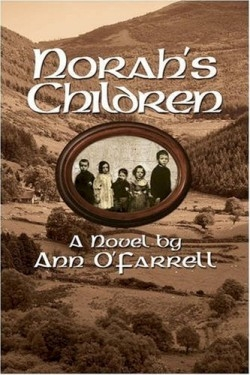Norah's Children
Brendan Kelly loved his wife. He gave her everything he could—although an emotionally impoverished man has little to offer. Together they produced five children but Brendan was a frustrated curmudgeon long before Norah the center of his life died. Realizing he could not care for his young family alone Brendan decided that he must have another wife. A few weeks after Norah’s death he married a girl he barely knew. The next morning he changed his mind and sent four of his children to live with new parents. This book follows the lives of Norah’s displaced babies.
Ann O’Farrell who holds a master’s degree from Trinity College in Dublin is a craftsman. Her prose is smooth precise and readable. For example she opens one chapter with two lines that set the scene the background and the situation: “It was a house of silence. Each morning Mrs. Kelly opened the back half-door to let light into the dark smoky cottage and then busied herself sweeping the hearth and the earthen floor.” Few authors can create mood so succinctly.
Her rendition of Irish Culture in the 1920s and ’30s educates and entertains like Oliver Twist or Jane Eyre. She explores regional culture as well as the religious class and political antipathies of the time. For example two of the children grow up in England. Returning many years later they face resentment from their British-hating relations. For siblings separated in childhood differences in speech patterns and clothing take on a bigger significance. Some of these issues are well known. However for modern-day audiences some of the social issues faced by the Kelly family will seem surprisingly restrictive.
O’Farrell’s characters are three dimensional and for the most part she lets them develop themselves. For example we watch Norah’s great aunt struggle to find homes for Norah’s semi-orphaned children. We see the impact of parental decisions on both Pierce and Michael Brendan’s oldest and youngest sons one embraced one abandoned—not in their words but in their actions.
The plot revolves around the agonizing question of “Why?” Why would Brendan marry a woman to take care of his children and then send all but one of them away the very next day? Why is his new bride angry and unhappy? Why does Brendan keep one child with him? The answer to this last question does not ring true and unfortunately it reads like a Perry Mason trial where the guilty party rushes to explain himself before the final commercial. On the other hand the ending is ironic given the fate of Norah’s children.
This work should find enthusiastic readers in young women who enjoy something a little more complex than the standard formulaic romance.
Reviewed by
Joyce Faulkner
Disclosure: This article is not an endorsement, but a review. The publisher of this book provided free copies of the book and paid a small fee to have their book reviewed by a professional reviewer. Foreword Reviews and Clarion Reviews make no guarantee that the publisher will receive a positive review. Foreword Magazine, Inc. is disclosing this in accordance with the Federal Trade Commission’s 16 CFR, Part 255.

